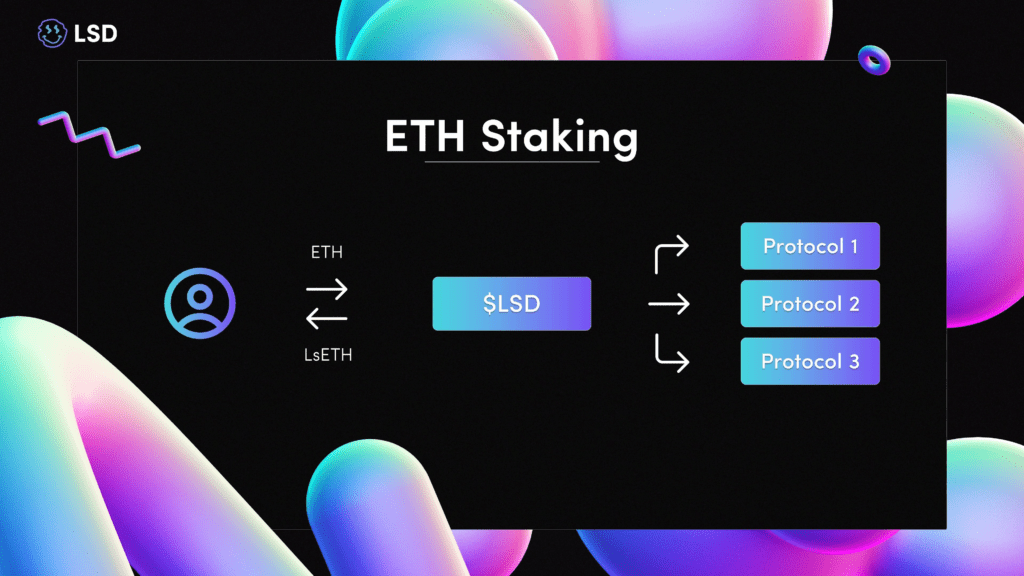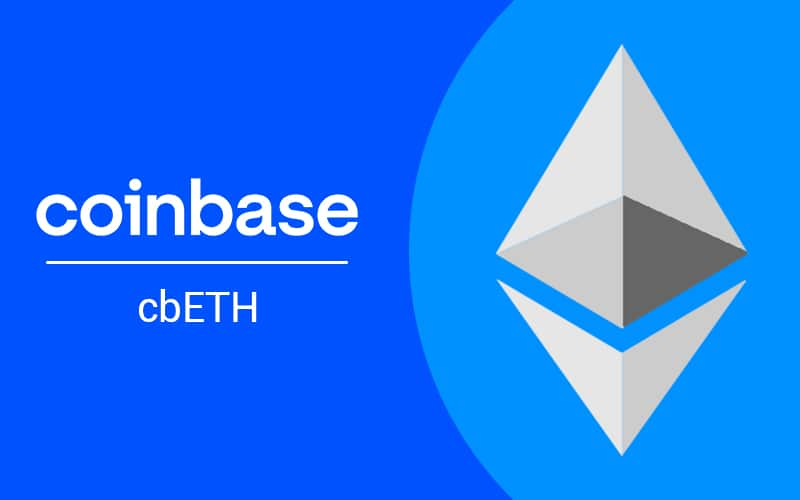More and more DeFi Protocols are starting to support LSD to provide a more flexible way to stake and earn. Liquid staking derivatives that offer a relatively new option to generate income through crypto are resonating with crypto enthusiasts. So what are the benefits it brings? Is this one of the driving forces behind Defi?
How does Liquid Staking Derivatives (LSD) stimulate DeFi activity?
Liquid staking derivatives are representations of the token holders’ staking assets. Liquid staking derivative token confirms bettors’ participation in the staking pool and this token can be used for lending, trading, and collateral worldwide decentralized finance (DeFi).
LSD caught the attention of DeFi users after Ethereum adopted a proof-of-stake (PoS) consensus algorithm, replacing mining with staking. ETH holders can now stake their tokens to maintain the network and generate annual profits.
However, two conditions limit access to staking to ordinary token holders. First, a minimum deposit limit of 32 Ether (ETH) is required to join the block validation war. Second, the ETH staked remains on the Beacon Chain until the Shanghai Ethereum update is complete, and even then, the rewards will gradually become available.

Liquidity staking protocols solve the first problem by pooling ETH from multiple holders to facilitate participation in Ethereum’s block validation process. Therefore, protocols like Lido allow ETH holders to stake without running a validator node.
Liquidity staking derivatives allow fractional deposits in their staking pool and offer derivative tokens to bettors based on 1:1 as Liquid staking derivatives.
Bettors can use these LSD tokens in the broader DeFi market to exploit profitable opportunities. Thanks to the LSD token, bettors can multiply the benefits of their locked tokens that would otherwise only generate staking rewards.
Advantages Of Liquid Staking Derivatives
Offer staking rewards
Earning recurring productivity rewards is one of the main reasons why many people start staking their tokens. Liquid staking also has other benefits, such as supporting a specific blockchain. With liquid staking, bettors receive the same staking rewards and bring the same benefits to their blockchain as regular staking. A staking bonus someone can earn from a liquid bet or more or less the same as you would expect from a regular chance.
These bonuses are primarily paid to bettors’ accounts daily and can be withdrawn anytime, but not all tokens have the same staking rewards. Furthermore, different staking platforms or networks also have different APYs and returns. Some prominent crypto investors currently liquidating coins include Cosmos’ ATOM, Binance’s BNB, and Persistence One’s XPRT. These coins are prevalent in the space, rank top in the market, and have many community members who greatly support them.
Provide liquidity for staked tokens
The benefits of liquid bets don’t just stop at the staking rewards. Liquidity related to liquid staking is a prominent feature that attracts users’ interest. Liquid staking allows you to earn derivative tokens that users can use to generate additional income. These derivative tokens are created through a liquidity staking platform and are what give users the liquidity they want.
Regular staking ensures you only earn recurring staking rewards, but with liquid staking, you get that bonus and derivative tokens. These tokens have many interests in the space. For starters, users can trade these tokens. The popularity of liquid staking has led platforms to develop a market for these tokens. These staking assets can be traded on PancakeSwap and SushiSwap for other tokens. These derivative tokens can be used to transfer funds. Staking assets are crypto-backed assets, and like any other currency, they can be transferred from one user to another via the blockchain. Thus, liquid staking allows crypto bettors to continue making transactions even with the tokens they are staking.
Allows you to maximize Yield Farming
Choosing to start liquid staking is a big move to expand your earnings in the crypto market, especially for those who use a regular staking platform. Liquid staking allows you to earn additional profit rewards and your regular staking bonus using derivative tokens.
Everyday use cases for these derivative tokens are prominent in the DeFi market through yield farming. This derivative liquidity staking token offers profitable farming opportunities on multiple DeFi platforms. People can use their staking assets on Defi platforms to earn additional yield farming rewards as liquidity providers. Users can use these productive farming opportunities to bet on different pools and make money. There are other DeFi platforms where you can also use your derivative tokens. Ultimately, liquid staking is an excellent addition to anyone’s profit-farming strategy and a means of optimizing your token return rewards.
Promote staking activity
Staking ETH and other tokens generate staking rewards for token holders and enhance the network’s stability and security. However, since regular staking requires token holders to lock their tokens, all token holders do not accept staking ETH or other tokens.
However, liquid staking derivatives provide the liquidity that token holders may need or want even if their tokens are staked. Thus, liquid staking motivates token holders to contribute to the network.
3 Protocols Best Liquid Staking Derivatives Protocol
The shared protocols below are ranked by DefiLlama according to TVL

Lido DAO

Lido DAO is one of the best and most popular liquidity staking protocols. It works with its native token, LDO. This is the governance token used to support ETH liquidity staking. When users stake ETH on Lido, they will receive stETH in exchange, and stETH can be used across the DeFi ecosystem for more rewards. The APR for ETH on the Lido DAO is 4.9%.
Notably, Lido DAO is a well-capitalized platform focusing on growth and enhancement. However, a large portion of Lido’s staking power is centralized, which risks a centralized attack. Lido charges a 10% fee, split equally between the DAO and the node operator.
Coinbase Wrapped Staked ETH

Coinbase says it will list Coinbase Wrapped ETH (cbETH) on the Ethereum network as an ERC-20 token, allowing customers to use their staked Ether while earning rewards on the exchange. According to its website, users can withdraw tokens to Coinbase, make a deposit, and then transfer ETH2 into cbETH, with the new staked token balance showing on their accounts.
Our top pick for DeFi returns on cbETH is Convex Finance. They offer 9.88% APY to provide liquidity for ETH/cbETH on the platform.
Your first reward payment will appear a few days after each purchase or transfer. You will then receive regular payouts from the ETH staking bonus, which will be added to your balance every 3 days.
Rocket Pool

Rocket Pool is a popular liquidity staking provider often compared to Lido. However, Lido works with permissioned node providers while Rocket Pool is decentralized.
Rocket Pool offers two types of staking options for ETH holders – rETH token staking and node staking. Staking rETH tokens allows users to stake as little as 0.01 ETH. The staked ETH will contribute to the deposit pool allowing Rocket Pool node operators to create a new Beacon Chain validator. In exchange for staking, users receive rETH which they can redeem for RPL rewards.
On the other hand, users with more capital can choose to bet on the button. This option is specially designed so that even those lacking technical expertise can benefit from one-button operation. Button staking requires the user to stake 16 ETH. The remaining 16 ETH to make up the full 32 ETH will come from the pool of deposits contributed by the rETH token staking. This will then set up a new Ethereum validator called a small pool.
Rocket Pool charges between 5% and 25% of staking rewards paid directly to node operators.
Conclusion
Liquid staking derivatives are shaking up the crypto world with the sole benefit of maintaining the liquidity of their tokens while also drawing out staking rewards. For many token holders, the flexibility this offers is a real boon.
The upcoming Shanghai upgrade will include a code, called EIP 4895, which will allow the withdrawal of staked ETH. The upgrade will allow 1:1 exchange of Beacon Chain staked ETH for ETH. This will incentivize more ETH to be staking through liquidity staking pools, which will drive demand for LSD and potentially trigger rapid growth in DeFi TVL.
DISCLAIMER: The Information on this website is provided as general market commentary and does not constitute investment advice. We encourage you to do your own research before investing.
Join us to keep track of news: https://linktr.ee/coincu
Foxy
Coincu News






















